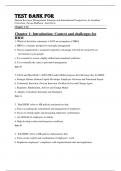Exam (elaborations)
Test Bank For Human Resource Management Strategic and International Perspectives 4th Edition by Jonathan Crawshaw, Pawan Budhwar, Ann Davis Chapter 1-14
- Course
- Institution
Test Bank For Human Resource Management Strategic and International Perspectives 4th Edition by Jonathan Crawshaw, Pawan Budhwar, Ann Davis Chapter 1-14
[Show more]



